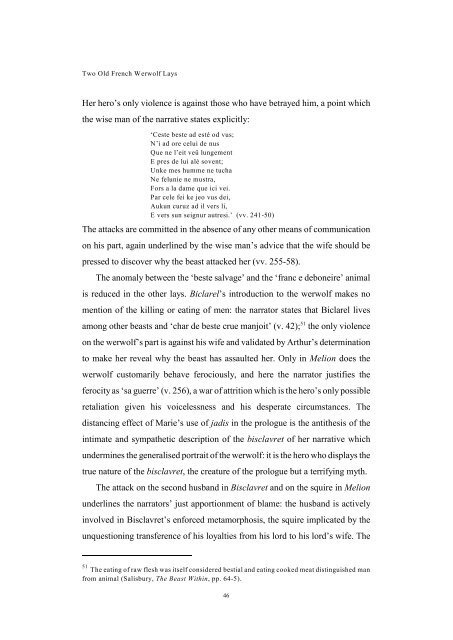Melion and Biclarel - University of Liverpool
Melion and Biclarel - University of Liverpool
Melion and Biclarel - University of Liverpool
You also want an ePaper? Increase the reach of your titles
YUMPU automatically turns print PDFs into web optimized ePapers that Google loves.
Two Old French Werwolf Lays<br />
Her hero’s only violence is against those who have betrayed him, a point which<br />
the wise man <strong>of</strong> the narrative states explicitly:<br />
‘Ceste beste ad esté od vus;<br />
N’i ad ore celui de nus<br />
Que ne l’eit veü lungement<br />
E pres de lui alé sovent;<br />
Unke mes humme ne tucha<br />
Ne felunie ne mustra,<br />
Fors a la dame que ici vei.<br />
Par cele fei ke jeo vus dei,<br />
Aukun curuz ad il vers li,<br />
E vers sun seignur autresi.’ (vv. 241-50)<br />
The attacks are committed in the absence <strong>of</strong> any other means <strong>of</strong> communication<br />
on his part, again underlined by the wise man’s advice that the wife should be<br />
pressed to discover why the beast attacked her (vv. 255-58).<br />
The anomaly between the ‘beste salvage’ <strong>and</strong> the ‘franc e deboneire’ animal<br />
is reduced in the other lays. <strong>Biclarel</strong>’s introduction to the werwolf makes no<br />
mention <strong>of</strong> the killing or eating <strong>of</strong> men: the narrator states that <strong>Biclarel</strong> lives<br />
51<br />
among other beasts <strong>and</strong> ‘char de beste crue manjoit’ (v. 42); the only violence<br />
on the werwolf’s part is against his wife <strong>and</strong> validated by Arthur’s determination<br />
to make her reveal why the beast has assaulted her. Only in <strong>Melion</strong> does the<br />
werwolf customarily behave ferociously, <strong>and</strong> here the narrator justifies the<br />
ferocity as ‘sa guerre’ (v. 256), a war <strong>of</strong> attrition which is the hero’s only possible<br />
retaliation given his voicelessness <strong>and</strong> his desperate circumstances. The<br />
distancing effect <strong>of</strong> Marie’s use <strong>of</strong> jadis in the prologue is the antithesis <strong>of</strong> the<br />
intimate <strong>and</strong> sympathetic description <strong>of</strong> the bisclavret <strong>of</strong> her narrative which<br />
undermines the generalised portrait <strong>of</strong> the werwolf: it is the hero who displays the<br />
true nature <strong>of</strong> the bisclavret, the creature <strong>of</strong> the prologue but a terrifying myth.<br />
The attack on the second husb<strong>and</strong> in Bisclavret <strong>and</strong> on the squire in <strong>Melion</strong><br />
underlines the narrators’ just apportionment <strong>of</strong> blame: the husb<strong>and</strong> is actively<br />
involved in Bisclavret’s enforced metamorphosis, the squire implicated by the<br />
unquestioning transference <strong>of</strong> his loyalties from his lord to his lord’s wife. The<br />
51<br />
The eating <strong>of</strong> raw flesh was itself considered bestial <strong>and</strong> eating cooked meat distinguished man<br />
from animal (Salisbury, The Beast Within, pp. 64-5).<br />
46
















